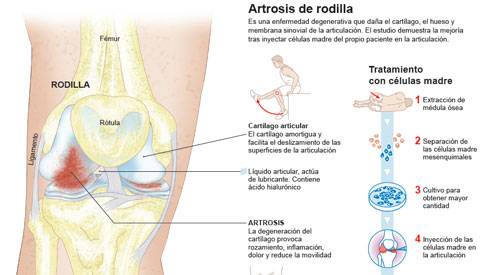Knee prosthesis
"Osteoarthritis is often associated with overweight and/or the presence of angular deformities, especially in the knee. The moment for placing a prosthesis must be carefully considered".
DR. ANDRÉS VALENTÍ AZCÁRATE SPECIALIST. ORTHOPEDIC SURGERY AND TRAUMATOLOGY DEPARTMENT

Knee prosthesis is a treatment that is frequently performed on patients suffering from knee arthrosis.
When the knee is so damaged and all other treatments have failed, the knee joint can be replaced with a prosthesis.
There is a wide variety of options that allow the surgeon to customize the knee prosthesis depending on the damage, age and physical activity level of the patient.
In order to offer the most adequate solution to each patient, the Orthopedic Surgery and Traumatology Department of the Clinic is organized in assistance units, among which is the hip and knee assistance unit. In this way, the professionals are dedicated in a preferential way to these diseases.
Likewise, the Clinic has an osteotendinous tissue bank that allows us to offer the best therapeutic alternatives to each patient.

When is a knee prosthesis indicated?
The knee joint is formed mainly by the union between two bones: the femur, which gives structure to the thigh area, and the tibia. It is a joint that frequently develops arthrosis by being "of burden" and supporting the weight of the whole body.
The bones that are inside the knee are covered with cartilage, that avoids the rubbing of bone with bone in the movements of the knee, facilitating the slide and cushioning the blows. It is the wear with the years and the aging of the cartilages what originates the arthritis.

Learn what osteoarthritis of the knee is all about (only in spanish).
Most frequent indications for this treatment:
Do you have very advanced osteoarthritis of the knee?
You may need a knee prosthesis
How is a knee prosthesis made?
La intervención de prótesis de rodilla
The surgery lasts one hour and may require blood transfusion.
When the deterioration of the knee and the pain prevent walking, the substitution of the articular surfaces by a prothesis is indicated. These are reproductions of the bones that make up the knee, made of various metals and plastic materials that favor the flexion and extension of the knee.
The surgical intervention is performed under general or epidural anesthesia. It is necessary to make an incision to cut and partially remove the part of the bones - femur, tibia and fibula - located in the area near the knee, to replace the joint with the prosthesis.
The type of implant used depends on the patient, his/her age and the state of the bones.
This operation lasts about an hour and, on occasion, may require a subsequent blood transfusion, since the section of the bones usually produces considerable blood loss. However, current techniques and blood salvage systems greatly reduce the need for a transfusion.
After the operation, a drainage tube can be kept in place to eliminate the blood residue accumulated on the surfaces of the sectioned bones, and this drainage must be monitored in order to control the degree of bleeding.
Recuperación de la intervención de rodilla con prótesis
More than 90% of the prostheses last more than 10 years
The patient who has a knee prosthesis implanted can usually get back to work within 3 to 6 months. Depending on the mobility of the knee, the patient is allowed to drive between one and two months after the operation.
As for the follow-up of the implant, more than 90% of the prostheses last more than 10 years. In the long term, the main problem that arises is the detachment or loosening of the components and the softening of the bones.
After a decade, 20% of the prostheses may show signs of loosening on X-rays, but only 10% cause discomfort and may require further intervention.
Where do we do it?
IN NAVARRA AND MADRID
The Department of Orthopedic Surgery and Traumatology
of the Clínica Universidad de Navarra
The Department of Orthopedic Surgery and Traumatology covers the full spectrum of congenital or acquired conditions of the musculoskeletal system including trauma and its aftermath.
Since 1986, the Clinica Universidad de Navarra has had an excellent bank of osteotendinous tissue for bone grafting and offers the best therapeutic alternatives.
Organized in care units
- Hip and knee.
- Spine.
- Upper extremity.
- Pediatric orthopedics.
- Ankle and foot.
- Musculoskeletal tumors.

Why at the Clinica?
- Experts in arthroscopic surgery.
- Highly qualified professionals who perform pioneering techniques to solve traumatological injuries.
- One of the centers with the most experience in bone tumors.




















